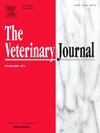口服和静脉注射二甲基甘氨酸对低强度运动马血液生化特征和总氧化剂/抗氧化状态的影响。
IF 3.1
2区 农林科学
Q1 VETERINARY SCIENCES
引用次数: 0
摘要
二甲基甘氨酸(DMG)可能有助于延缓肌肉疲劳和防止运动动物运动引起的肌肉损伤。本研究探讨了静脉注射和口服DMG对运动马生理、血液学、生化、血气和氧化应激参数的影响。在这项研究中,30匹土耳其阿拉伯马鞍马被随机分为三组。A组马静脉注射10% DMG 15ml (1500mg),每天2次,连续3天。B组马口服DMG粉1500mg,每日2次,连用3天;C组(对照)马注射0.9% NaCl溶液15ml,每日2次,连用3天。在最后一剂药之后,所有的马都进行了有氧运动,包括30分钟的慢跑,15分钟的热身和15分钟的步行冷却。在运动前-2h、运动后立即(0h)和运动后2、4、6小时评估生命和血液生化参数。测量心率(HR)、呼吸频率(RR)和直肠温度(RT)以排除运动引起的热应激。采用总氧化状态(TOS)、总抗氧化状态(TAS)及其比值氧化应激指数(OSI)评价静息和运动后的氧化应激。其他用于排除亚临床感染和肌肉损伤的血常规参数包括白细胞计数(WBC)、天冬氨酸转氨酶(AST)、肌酸激酶(CK)、乳酸脱氢酶(LDH)、肌酐和尿素。这些参数均未提示存在亚临床疾病。正如预期的那样,心率(HR)、呼吸频率(RR)和直肠温度(RT)在运动后显示出轻微的升高;然而,没有证据表明运动引起热应激。血气参数保持在生理范围内,与对照组相比,DMG治疗在运动后0、2和4小时的乳酸水平趋于稳定。与对照组相比,两组的TOS水平均显著降低(p本文章由计算机程序翻译,如有差异,请以英文原文为准。
Effects of oral and intravenous dimethylglycine treatment on hematobiochemical profiles and total oxidant/antioxidant status in low-intensity exercised horses
Dimethylglycine (DMG) may help delay muscle fatigue and prevent exercise-induced muscle damage in athletic animals. This study investigated the effects of intravenous and oral DMG on physiological, hematological, biochemical, blood gas, and oxidative stress parameters in exercising horses. In this study, 30 Turkish Arab saddle horses were randomly divided into three groups. Group A horses were injected intravenously with 15 mL (1500 mg) of a 10 % DMG twice daily for three days. Group B horses received 1500 mg DMG powder orally twice daily for three days, and group C (control) horses were injected with 15 mL 0,9 % NaCl solution twice daily for three days. Following the last dose, all horses were subjected to aerobic exercise, including 30 min of cantering, with a 15-minute warm-up and a 15-minute walking cool-down. Vital and hematobiochemical parameters were evaluated at −2 h (pre-exercise), immediately after exercise (0 h), and at 2, 4, and 6 h post-exercise. Heart rate (HR), respiratory rate (RR), and rectal temperature (RT) were measured to exclude exercise-induced heat stress. Total oxidative status (TOS), total antioxidant status (TAS), and their ratio, the oxidative stress index (OSI), were used to evaluate oxidative stress at rest and after exercise. Other routine blood parameters used to exclude subclinical infection and muscle damage included white blood cell count (WBC), aspartate aminotransferase (AST), creatine kinase (CK), lactate dehydrogenase (LDH), creatinine, and urea. None of these parameters suggested the presence of subclinical disease. As expected, heart rate (HR), respiratory rate (RR), and rectal temperature (RT) showed mild increases following exercise; however, there was no evidence of exercise-induced heat stress. Blood gas parameters remained within physiological limits, and DMG treatment appeared to stabilize post-exercise lactate levels at 0, 2, and 4 h compared to controls. TOS levels were significantly decreased in both treatment groups compared to controls (p < 0.05), particularly following IV administration immediately after exercise (0 h). TAS levels were also lower in DMG-treated horses, likely reflecting greater antioxidant utilization during exercise. However, OSI values did not differ significantly between groups. These findings suggest that DMG, especially when administered intravenously, may help balance oxidative stress and reduce markers of muscle damage in exercising horses, without compromising physiological homeostasis. However, further studies are required to better understand its role and long-term benefits.
求助全文
通过发布文献求助,成功后即可免费获取论文全文。
去求助
来源期刊

Veterinary journal
农林科学-兽医学
CiteScore
4.10
自引率
4.50%
发文量
79
审稿时长
40 days
期刊介绍:
The Veterinary Journal (established 1875) publishes worldwide contributions on all aspects of veterinary science and its related subjects. It provides regular book reviews and a short communications section. The journal regularly commissions topical reviews and commentaries on features of major importance. Research areas include infectious diseases, applied biochemistry, parasitology, endocrinology, microbiology, immunology, pathology, pharmacology, physiology, molecular biology, immunogenetics, surgery, ophthalmology, dermatology and oncology.
 求助内容:
求助内容: 应助结果提醒方式:
应助结果提醒方式:


